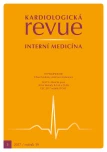SGLT2 inhibitors (gliflozins) antidiabetics, antihypertensives or drugs for heart failure?
Authors:
J. Špinar 1; J. Vítovec 2; L. Špinarová 2
Authors‘ workplace:
Interní kardiologická klinika LF MU a FN Brno
1; I. interní-kardioangiologická klinika LF MU a FN u sv. Anny v Brně
2
Published in:
Kardiol Rev Int Med 2017, 19(3): 195-200
Overview
SGLT2 inhibitors – gliflozins were introduced into clinical practice as oral antidiabetics, acting by increased glucose excretion in urine using the blockade of the SGLT2 co-transporter, which blocks glucose reabsorption in kidneys. The first big clinical trial EMPA REG outcome has shown not only the effect on diabetes mellitus but also the effect on cardiovascular events, decreasing especially heart failure mortality and hospitalisations. A decrease in body weight by 2– 3 kg and a decrease of systolic blood pressure by 3– 5 mmHg were also new findings. The CANVAS trials were presented in 2017 and confirmed this beneficial effect, but also bring new disappointing information about increase of leg amputations. Data from real life – CVD REAL research disprove the doubts on more than 300,000 patients from all over the world and confirm the positive results from clinical trials. A large program with dapagliflozin is being conducted. A meta-analysis of 21 clinical trials confirmed the positive trend in cardiovascular events and the results of the DECLARE study are being awaited with great expectations. The DAPA HF trial started in 2017 and investigates the effect of dapagliflozin in patients with chronic heart failure with or without diabetes mellitus. The EMPEROR trials with empagliflozin in patients with both systolic and diastolic failure were also started in 2017.
Keywords:
SGLT2 – diabetes mellitus – heart failure – dapagliflozin – empagliflozin
Sources
1. Khaw KT, Wareham N, Bingham S et al. Association of hemoglobin A1c with cardiovascular disease and mortality in adults: the European prospective investigation into cancer in Norfolk. Ann Intern Med 2004; 141(6): 413– 420.
2. Špinar J, Hradec J, Špinarová L et al. Summary of the 2016 ESC Guidelines on the diagnosis and treatment of acute and chronic heart failure. Prepared by the Czech Society of Cardiology. Cor Vasa 2016; 58: 530– 568. doi: 10.1016/ j.crvasa.2016.09.004.
3. Ferrannini E, Muscelli E, Frascerra S et al. Metabolic response to sodium-glucose contransporter 2 inhibition in type 2 diabetic patients. J Clin Invest 2014; 124(2): 499– 508. doi: 10.1172/ JCI72227.
4. Hummel CS, Lu C, Loo DD et al. Glucose transport by human renal Na+/ D-glucose cotransporters SGLT1 and SGLT2. Am J Physiol Cell Physiol 2011; 300(1): C14– C20. doi: 10.1152/ ajpcell.00388.2010.
5. Šoupal J, Prázný M. Postavení nových antidiabetik v klinické praxi: SGLT2 vs DPP4 inhibitory. Vnitř Lék 2015; 61(4): 291– 294.
6. Kvapil M. EMPA REG OUTCOME. Důkaz, že populace pacientů s diabetem se mění. Remedia 2016; 26(1): 67– 72.
7. McGill JB. The SGLT2 inhibitor empagliflozin for the treatment of type 2 diabetes mellitus: a bench to bedside review. Diabetes Ther 2014; 5(1): 43– 63. doi: 10.1007/ s13300-014-0063-1.
8. Vítovec J, Špinar J, Špinarová L. Empagliflozin a srdeční selhání. Hypertenze a KV prevence 2016; 5(2): 19– 23.
9. Zinman B, Wanner CH, Lachin JM et al. The EMPA-REG OUTCOME investigators: empagliflozin, cardiovascular outcomes, and mortality in type 2 diabetes. N Engl J Med 2015; 373(22): 2117– 2128. doi: 10.1056/ NEJMoa1504720.
10. Sattar N, Petrie MC, Zinnad B et al. Novel diabetes drugs and the cardiovascular specialist. J Am Coll Cardiol 2017; 69(21): 2646– 2656. doi: 10.1016/ j.jacc.2017.04.014.
11. Fioretto P, Giaccari A, Sesti G. Efficacy and safety of dapagliflozin, a sodium glucose cotransporter 2 (SGLT2) inhibitor, in diabetes mellitus. Cardiovasc Diabetol 2015; 14: 142. doi: 10.1186/ s12933-015-0297-x.
12. Fioretto P, Stefansson BV, Johnsson E et al. Dapagliflozin reduces albuminuria over 2 years in diabetic patients with renal impairment. Diabetologia 2016; 59(9): 2036– 2039. doi: 10.1007/ s00125-016-4017-1.
13. Špinar J, Lábrová R. Dapagliflozin a studie DECLARE – budoucnost léčby diabetes mellitus. Kardiol Rev Int Med 2016; 18(2): 119– 124.
14. Goto A, Arah OA, Goto M et al. Severe hypoglycaemia and cardiovascular disease: systematic review and meta-analysis with bias analysis. BMJ 2013; 347: f4533.
15. Sonesson C, Johansson PA, Johnsson E et al. Cardiovascular effects of dapagliflozin in patients with type 2 diabetes and different risk categories: a meta-analysis. Cardiovasc Diabetol 2016; 15: 37. doi: 10.1186/ s12933-016-0356-y.
16. Fabiánová J. Kardiovaskulární účinky dapagliflozinu u pacientů s diabetes mellitus 2. typu a různou úrovní rizika. Farmakoterapie 2016; 12(1): 1– 200.
17. Kosiborod M, Cavender MA, Fu AZ et al. The CVD-REAL Investigators and Study Group. Lower risk of heart failure and death in patients initiated on SGLT-2 inhibitors versus other glucose-lowering drugs. Circulation 2017; 136(3): 249– 259. doi: 10.1161/ CIRCULATIONAHA.117.029190.
18. Neal B, Perkovic V, Mahaffey KV. The CANVAS Program Collaborative Group. Canagliflozin and cardiovascular and renal events in type 2 diabetes. N Engl J Med 2017; 377(7): 644– 657. doi: 10.1056/ NEJMoa1611925.
19. Braunwald E. The war against heart failure. Lancet 2015; 385(9970): 812– 824. doi: 10.1016/ S0140-6736(14)61889-4.
20. Ambrosy AP, Fonarow GC, Butler Jet al. The global health and economic burden of hospitalizations for heart failure: lessons learned from hospitalized heart failure registries. J Am Coll Cardiol 2014; 63(12): 1123– 1133. doi: 10.1016/ j.jacc.2013.11.053.
21. Vítovec J, Špinar J, Špinarová L. Diabetes s kardiovaskulárním onemocněním – co s tím? Acta Medicinae 2017; 2: 76– 78.
22. Cook C, Cole G, Asaria P et al. The annual global economic burden of heart failure. Int J Cardiol 2014; 171(3): 368– 376. doi: 10.1016/ j.ijcard.2013.12.028.
23. Ponikowski P, Voors AA, Anker SD et al. 2016 ESC Guidelines for the diagnosis and treatment of acute and chronic heart silure. Eur Heart J 2016; 37(27): 2129– 2200. doi: 10.1093/ eurheartj/ ehw128.
Labels
Paediatric cardiology Internal medicine Cardiac surgery CardiologyArticle was published in
Cardiology Review

2017 Issue 3
Most read in this issue
- Cardiovascular risk stratification and new serum lipid target levels
- SGLT2 inhibitors (gliflozins) antidiabetics, antihypertensives or drugs for heart failure?
- Statin intolerance – finding practical solutions
- Infective Endocarditis
